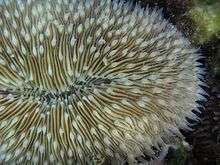Fungia scutaria
| Fungia scutaria | |
|---|---|
 | |
| Scientific classification | |
| Kingdom: | Animalia |
| Phylum: | Cnidaria |
| Class: | Anthozoa |
| Order: | Scleractinia |
| Family: | Fungiidae |
| Genus: | Fungia |
| Species: | F. scutaria |
| Binomial name | |
| Fungia scutaria Lamarck, 1801 [1] | |
Fungia scutaria is a species of plate or mushroom coral in the family Fungiidae. It is found in the Indo-Pacific region.
Description
Fungia scutaria is a solitary, non-colonial coral that is free living and not attached to the seabed. It is discoid or elongated in shape and can grow to a very large size. The polyp can be up to 17 centimetres (6.7 in) long [2] and is embedded in a cup shaped hollow known as a corallite, surrounded by calcareous material. Lining this are narrow ribs known as septa, each having a tall tentacular lobe near its origin in the centre. The septa bear unlobed teeth and further tentacular lobes at intervals where the septa divide. Outside the corallite the ribs continue, now known as costae, bearing rows of tiny spines. The underside of the coral bears a scar resulting from its detachment from the sea bed as a juvenile. The colour varies, often being brown, yellowish or blue with contrasting tentacular lobes. The polyp has a central, slit-like mouth and a small number of short, tapering tentacles.[3][4]
Distribution and habitat
Fungia scutaria occurs in the Indian Ocean on upper reef slopes especially where there is considerable movement of the water as a result of wave action. It is usually found on sand or beds of coral fragments. It is often associated with other species of Fungia.[2]
Biology
Fungia scutaria is a carnivore and catches plankton, shrimps and fish with its tentacles.[4]
Fungia scutaria is a hermaphrodite. Eggs and sperm are ejected through the mouth and after fertilisation, develop into planula larvae which form part of the plankton. After some time these settle on the seabed and undergo metamorphosis. The juveniles attach themselves to the substrate and start feeding, extruding their hard skeletons and growing. At a later stage they become detached from their base and drift around on the sea bed. The polyps feed by day as well as by night.[4]
References
- ↑ WoRMS (2010). "Fungia scutaria Lamarck, 1801". World Register of Marine Species. Retrieved 2011-12-14.
- 1 2 Fungia scutaria Corals of the World online. Retrieved 2011-12-14.
- ↑ Fungia (mushroom coral) Reef coral genera of the Western Indian Ocean. Retrieved 2011-12-14.
- 1 2 3 Plate Coral- Fungia scutaria LHS Virtual Zoo. Retrieved 2011-12-14.